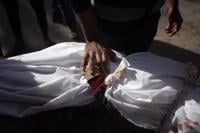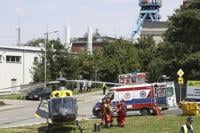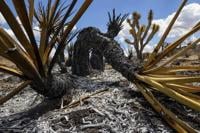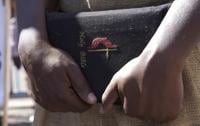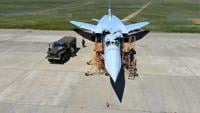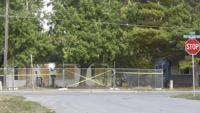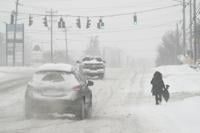JERUSALEM (AP) — Palestinian militants carried out the deadliest single attack on Israeli forces in Gaza since the Hamas raid that triggered the war, killing 21 soldiers, the military said Tuesday — a significant setback that could add to mounting calls for a cease-fire.
Hours later, the military announced that ground forces had encircled the southern city of Khan Younis, Gaza’s second largest, and thick, black smoke could be seen rising over the city as thousands of Palestinians fled south. Witnesses said Israeli tanks and troops had also moved into Muwasi, a nearby coastal area that the military had previously declared a safe zone for Palestinians.
Prime Minister Benjamin Netanyahu mourned the Israeli soldiers, who died when the blast from a rocket-propelled grenade triggered explosives they were laying to blow up buildings. But he vowed to press ahead until “absolute victory,” including crushing Hamas and freeing more than 100 Israeli hostages still held by the militants.
Israelis are increasingly questioning whether it’s possible to achieve those .
In the wake of Hamas’ Oct. 7 attack, outraged Israelis set aside long-simmering political differences and rallied behind the war. More than 100 days later, divisions are reemerging, and anger is growing over Netanyahu’s conduct of the war. have called for Israel to reach a deal with Hamas, saying time is running out to bring their relatives home alive.
A senior Egyptian official said Israel has proposed a two-month cease-fire in which the hostages would be freed in exchange for the release of Palestinians imprisoned by Israel, and top Hamas leaders in Gaza would be allowed to relocate to other countries.
The official, who was not authorized to brief media and spoke on condition of anonymity, said Hamas rejected the proposal and insists no more hostages will be released until Israel ends its offensive and withdraws from Gaza. Israel’s government declined to comment on the talks.
Egypt and Qatar — which have brokered past agreements between Israel and Hamas — were developing a multistage proposal to try to bridge the gaps, the official said.
‘ONE OF THE HARDEST DAYS’ FOR ISRAEL
Israeli reservists were preparing explosives Monday to demolish two buildings outside central Gaza’s Maghazi refugee camp, near the Israeli border, when a militant fired a rocket-propelled grenade at a tank nearby. The blast triggered the explosives, collapsing both two-story buildings onto the soldiers.
Israeli media said the troops were working to create an informal buffer zone, about a kilometer (half a mile) wide along the border to prevent militants from attacking Israeli communities near Gaza. Military spokesperson Daniel Hagari said the mission was to clear buildings to “create the conditions" that would allow the residents of the south to return to their homes.
The United States has said it would oppose any attempt by Israel to shrink Gaza’s territory.
Throughout the war, Israeli troops have used controlled detonations to destroy structures that the military says or have been used by militants as firing positions — wreaked by the ground offensive. Blasts have destroyed entire city blocks, apartment complexes, government buildings and universities, fueling Palestinians’ fears that the territory will be left unlivable.
At least 217 soldiers have been killed since the ground offensive began in late October, including three killed in a separate event Monday, according to the military.
Netanyahu acknowledged on social media that it was “one of the hardest days” of the war but vowed to keep up the offensive.
“We are in the middle of a war that is more than justified. In this war, we are making big achievements, like the encircling of Khan Younis, and there are also very heavy losses,” he later said in a video statement.
Israel launched its offensive after Hamas crossed the border Oct. 7, killing over 1,200 people and abducting some 250 others. More than 100 were released in November during a .
The offensive has caused widespread death and destruction, killing at least 25,490 people — the majority women and children — and wounding another 63,354, according to . Its count does not differentiate between civilians and combatants. An estimated 85% of Gaza’s 2.3 million people have been driven from their homes in a humanitarian crisis that has left one-quarter of the population .
TROOPS IN THE ‘SAFE ZONE’
With fighting raging in neighboring Khan Younis city, witnesses said that in the past few days Israeli troops and tanks had entered parts of Muwasi. Previously, the military had told Palestinians to take refuge in the tiny rural area on the Mediterranean coast, saying it would be spared military operations.
On Monday, troops stormed Al-Khair Hospital inside the zone and struck the nearby Al-Aqsa University where displaced people were sheltering, according to health officials.
The advance sent families who had fled to the area from fighting elsewhere fleeing once more, said one witness, Aseel al-Muqayed. One main street “had been very crowded with displaced people, you could hardly find a place without a tent. Now the area is almost empty,” she said, adding that she had seen tanks now stationed nearby.
The 21-year-old al-Muqayed has already been displaced multiple times since her family evacuated from northern Gaza. They moved repeatedly, fleeing bombardment — her younger brother and a cousin were killed in a strike that hit one of their refuges — and eventually ended up in Khan Younis. She came to Muwasi several days ago, learning there was electricity there to charge her mother's phone, and now was afraid to move.
“For two nights, we have not been able to sleep as the sounds of tanks, gunfire and explosions are very close,” she said.
Inside Khan Younis, heavy fighting raged around the two main hospitals. Shelling hit the fourth floor of Al-Amal Hospital, killing one person and wounding 10 others, according to Raed al-Nems, a spokesperson for the Palestine Red Crescent rescue service that runs the facility.
Shelling on Monday also hit a United Nations school that was sheltering displaced people in the city, killing at least six people, according to the U.N. agency for Palestinian refugees, known as UNRWA.
Israel’s offensive has focused for weeks on Khan Younis and several urban refugee camps in central Gaza, after the military claimed to have largely defeated Hamas in the north.
Israel believes Hamas commanders may be hiding in tunnels beneath Khan Younis, the hometown of the group’s , whose location is unknown.
PRESSURE FOR A CEASE-FIRE
The growing death toll and dire humanitarian situation have led to increasing international pressure on Israel to scale back the offensive and agree to a path for the creation of a Palestinian state after the war. The United States, which has , has joined those calls.
But Netanyahu, whose popularity has plummeted since Oct. 7 and whose governing coalition is beholden to far-right parties, has rebuffed both demands.
Instead, he has said Israel will need to expand operations and eventually take over the Gaza side of the border with Egypt — an area where some 1 million Palestinians are packed into overflowing U.N.-run shelters and sprawling tent camps.
That drew an angry protest from Egypt’s government, which rejected Israeli allegations that Hamas smuggles in weapons across the heavily guarded frontier.
Diaa Rashwan, head of Egypt’s State Information Service, said Monday that any Israeli move to occupy the border area would “lead to a serious threat” to relations between the two countries, which signed a landmark peace treaty over four decades ago. Egypt is also deeply concerned about into its Sinai Peninsula.
___
This story has been updated to correct that the attack on Israeli soldiers took place near Maghazi, not in Maghazi.
___
Magdy reported from Cairo and Jobain from Rafah, Gaza Strip. Associated Press writer Melanie Lidman in Jerusalem contributed to this report.


